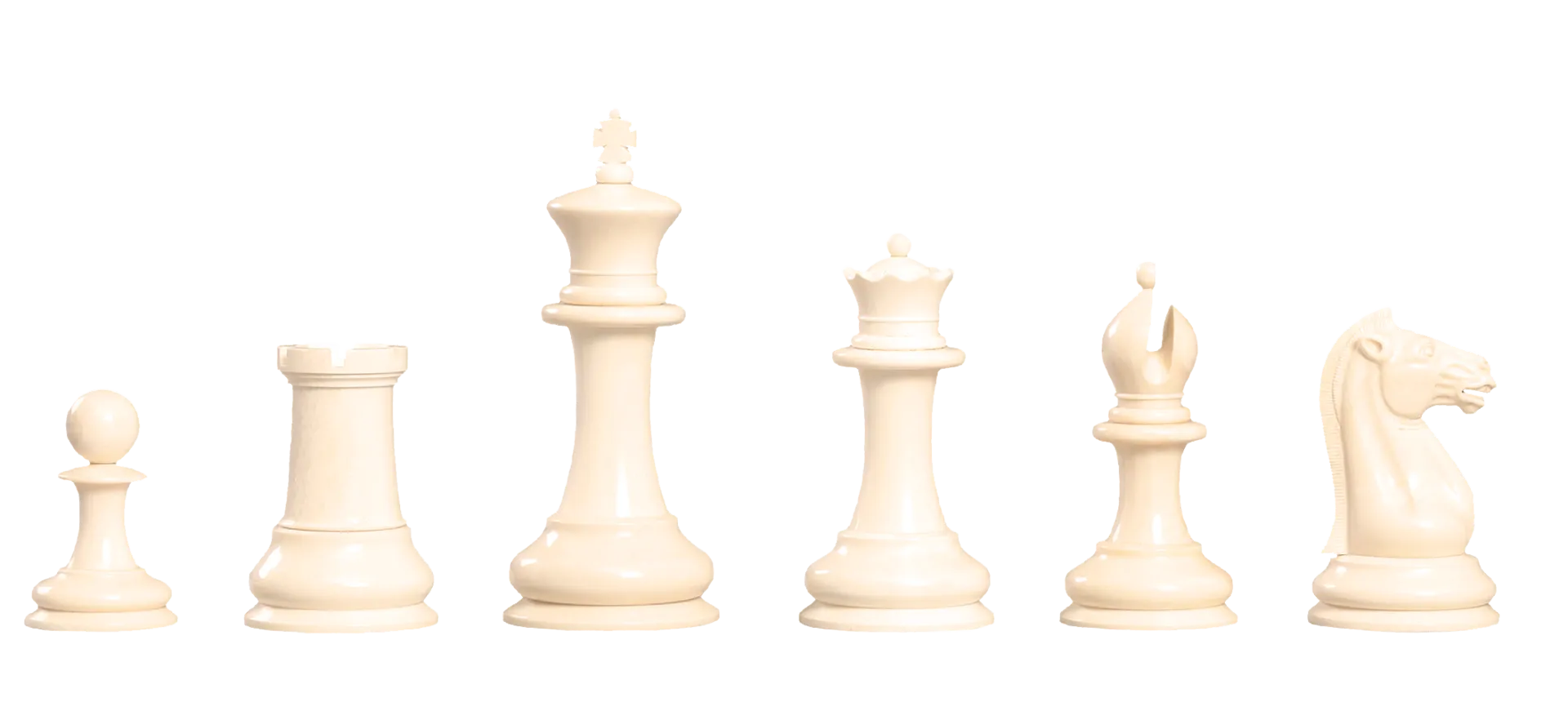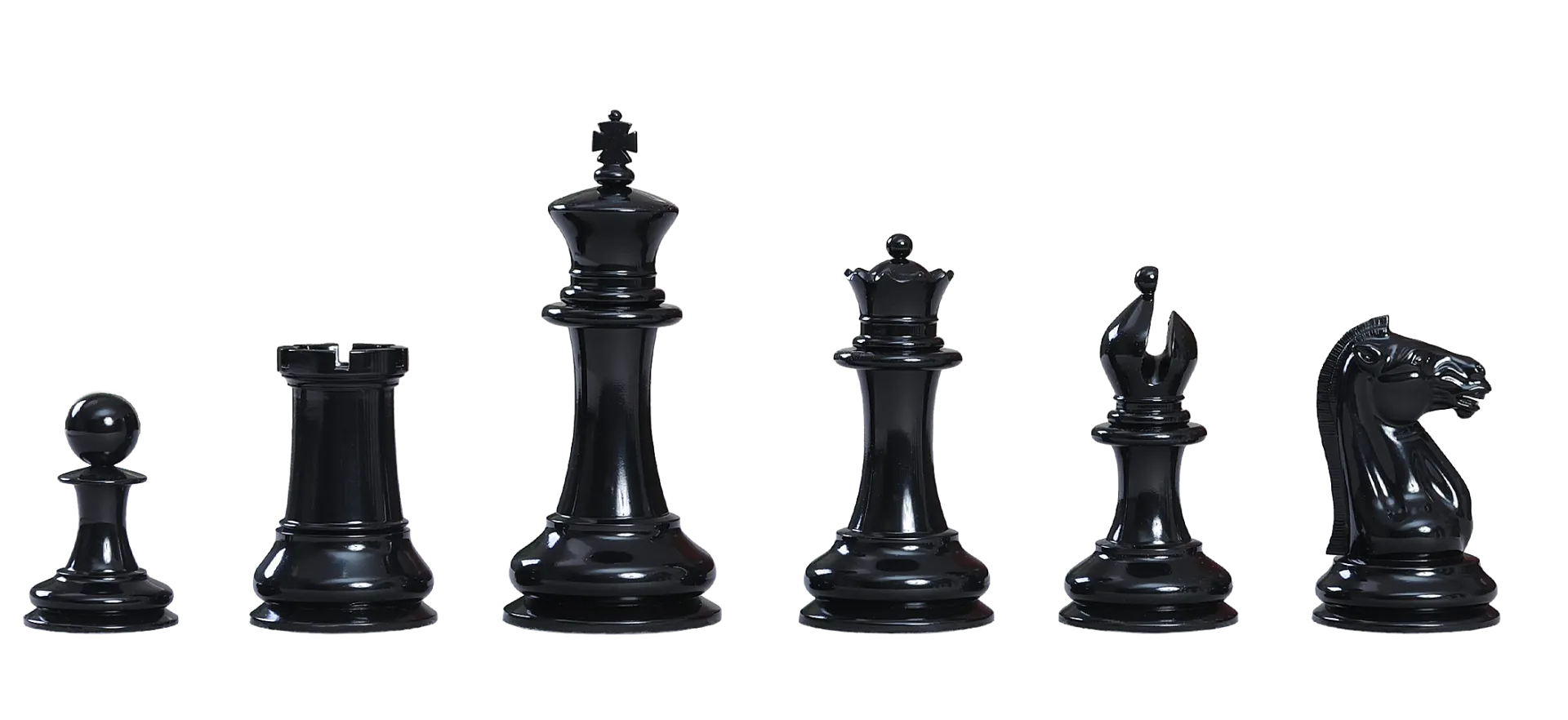Step 1 - Material
 The Mammoth Ivory Selene Collector Series Luxury Chess Pieces - 4.4" King
The Mammoth Ivory Selene Collector Series Luxury Chess Pieces - 4.4" King


Step 2 - Would you like to Add a Board?
Do not add a board

Tournament
Our Tournament Wood Chess Boards are affordable, ideal for both serious and casual play, and feature House of Staunton Logo.
Savings of $10
When Bundled with Chess Pieces

Standard
Our Standard Wood Chess Boards offer the perfect combination of affordability & luxury, and are available in a variety of woods.
Savings of $20
When Bundled with Chess Pieces

Superior
Our Superior Wood Chess Boards are designed for the discerning player, crafted in Europe from exotic woods.
Savings of $20
When Bundled with Chess Pieces

Signature
Our Signature Wood Chess Boards are handcrafted out of solid woods and are the finest chess boards available.
Savings of $50
When Bundled with Chess Pieces

eBoard

Step 3 - Would you like to Select Your Box?
Do not select your box

The Mammoth Ivory Selene Collector Series Luxury Chess Pieces - 4.4" King
THIS ITEM IS IN STOCK!!

PRICE MATCH GUARANTEE
Found this item at a lower price elsewhere? We'll match it!* Certain restrictions apply.
*** THIS ITEM IS IN STOCK AND AVAILABLE FOR IMMEDIATE DELIVERY! ***
"Crafted from 40,000-year old Woolly Mammoth Ivory, they capture the exquisite design and proportions of the original Staunton pattern Chess set, registered by Nathaniel Cooke and produced by Jaques of London in 1849."
To pamper you, The House of Staunton is proud to offer the Mammoth Ivory & Selene Series Luxury Chess set. This heirloom quality Chess set features a 4.4" King with a 2.0"diameter base. The Chess pieces are hand carved by our master artisans and crafted out of the finest materials. Because of the natural weight of Mammoth Ivory, the pieces have an excellent feel that does not require any artificial weighting. The opposing army is also crafted from Mammoth Ivory.
The Chessmen are new and each set consists of 34 Chessmen, including four Queens, a standard that was introduced by The House of Staunton in 1993.
The Chess Set comes with a personalized Certificate of Authenticity and an original manufacturer's label indicating the production number, with an adhesive backing that would allow it to be affixed to the underside of a Chess box.
1849 Selene Imperial Staunton Chessmen
This is an exact reproduction of the original Club-Size Nathaniel Cooke 1849 Staunton Chessmen. The unique design feature of this set of chess pieces is the Knight, which is an exact replica of the horse pulling Selene’s Chariot taken from the East Pediment of the Greek Parthenon. This particular sculpture was the inspiration for the Knights used in the original Staunton design. This is a full Club-size set, featuring a 4.4″ King with a 2.0″ diameter base. The chessmen are crafted from the finest grade of Mammoth tusk. This set of chessmen includes an extra pair of Queens to
assist during Pawn Promotion, a feature pioneered by House of Staunton in 1993.
The Chess Set comes with a personalized Certificate of Authenticity and an original manufacturer's label indicating the production number, with an adhesive backing that would allow it to be affixed to the underside of a Chess box.
Some Background
The Staunton pattern chess pieces are today the World standard for serious and casual play. The relatively low production cost brought chess to the masses and did much to popularize the game. In 1849, this new design was revolutionary. It was simple and elegant. The original design looks as modern today as it did upon its introduction over 166 years ago. However, this upstart met with some resistance from the established Chess Clubs and many players. Here are some insights into the ideas behind this new paradigm.
The design of the Staunton Chessmen was registered by Nathaniel Cooke in March of 1849. Sole authorization to produce the chessmen was given to the Firm of John Jaques of London.
Inspiration for the Design of the Staunton Knights was derived from the Elgin Marbles, whose visages of the noble steeds graced the East Pediment of the Greek Parthenon which stood atop
the Acropolis. The distinctive, finely detailed Knight design drew heavily upon the horse seen pulling the Moon Goddess Selene as its inspiration. This Knight is the hallmark of the Staunton
design. Over time, whether due to the demands of the market to mass produce chess sets cheaply, lack of carving skill, or simply ignorance of their true design origins, Knights in contemporary Staunton chess sets are often artistically challenged and a far cry from the original design intent.
The Staunton Bishop’s wide, open-mitered headpiece was an abstract representation of a flame (tongues of fire), the ecclesiastical representation for Wisdom, which in Christianity represents enlightenment imparted by the Holy Spirit. Contemporary Bishop designs have lost that original religious connection. The Rook design is self-evident. The Kings and Queens are represented by
their respective headpieces resting plush pillows sitting atop gracefully curved columns. The Pawn is said to represent the Freemason’s Square and Compass, a rather obscure reference and
one which is open to some debate.
The Elgin Marbles
The Parthenon Marbles, also known as the Elgin Marbles, is a collection of classical Greek marble sculptures (mostly by Phidias and his assistants), inscriptions and architectural members that originally were part of the Parthenon and other buildings on the Acropolis of Athens. The fascinating story behind these marble sculptures is rooted in Greek Mythology. On the far-right corner of the East Pediment there is a marble sculpture of the head of a horse spilling over the beam and known as the Head of the Horse of Selene’s Chariot.
The horse was part of a larger ensemble of horses pulling a chariot. The chariot represented the moon (Selene) which the horses, now exhausted, were pulling into the sea after racing across the night sky. The left corner of the pediment contained a second set of horses and chariot representing the sun rising out of the sea. The sculptor has masterfully captured the weariness of the horse, with its flaring nostrils, bulging eyes, and drooping jaw.
There is more to this captivating story. Thomas Bruce, the 7th Earl of Elgin, obtained a controversial permit from the Ottoman authorities to remove pieces of the Friezes from the Parthenon
while serving as the British ambassador to the Ottoman Empire from 1799 to 1803. From 1801 to 1812, Elgin’s agents removed about half of the surviving sculptures of the Parthenon as well
as some other choice sculptures. The Marbles were then transported by sea to Britain. Greece has demanded that the Marbles be returned to their proper place and critics have compared Elgin’s actions to vandalism or looting.
-
ISBN
-
Does not apply
-
Weighting
-
Solid Mammoth Ivory - No Additional Weighting
-
King Height
-
4.4'' inch / 11.18 cm
-
King Base Diameter
-
2.0'' inch / 5.0 cm
-
Basepad Material
-
Because the Pieces are Mammoth Ivory, there are no basepads to allow you to appreciate the beauty of the Mammoth Ivory
-
Material(s)
-
Mammoth Ivory
-
Total Number of Pieces
-
34 Chess Pieces, including 2 Additional Queens (for Pawn Promotion)
-
Fitted Coffer Compatible?
-
Fits in Fitted Coffer
-
Included with Purchase
-
Certificate of Authenticity, Engraved Registered Plaque, and Individual Production Number
-
Chess Board Included?
-
The Chess Board featured is for photographic purposes only and must be purchased separately
-
Recommended Chess Board Size
-
2.5" inch / 6.4 cm
Included with Purchase
- Certificate of Authenticity
- Engraved Registered Plaque
- Individual Production Number
History of the Chess Pieces
|
|
The Mammoth Ivory is excavated from the permafrost of the Siberian tundra, which the woolly mammoth inhabited for more than 160,000 years. During the last ice age, the mammoth went extinct as the direct result of rapidly plummeting temperatures that literally flash froze the entire population of Mammuthus primigenius. The dry, cold environment of Siberia combined with the massive sheets of ice from the ice age created the ideal environment for the preservation of Mammoth Ivory. The woolly Mammoth have been entombed under the Siberian permafrost ever since, waiting to be unearthed. For more than 2,000 years, Mammoth Ivory has been traded and it remains a highly prized commodity across the world. While that demand for the Mammoth Ivory has always been higher than its supply, it skyrocketed in 1963 when the CITES agreement was enacted. This agreement banned all sales of new Elephant or Walrus Ivory, in an effort to protect the animals from extinction. As a result, Mammoth Ivory became the only type of animal-based ivory that is exempt from the international trade restrictions because it is considered to be a fossil. Over the past few years, the price of Mammoth Ivory has more than doubled, due largely to the unprecedented demand for luxury goods from such emerging countries as India and China. This trend is expected to continue. Less than one percent of the Mammoth Ivory harvested is of suitable quality for the manufacturing of Chess pieces, making these exquisite Chessmen a rare treasure to behold. |
Return Information
This item is made on a bespoke (custom order) basis only and is manufactured to your exact specifications. As a result, we will not be able to honor any order cancellation, return or exchange requests for this item.

















